|
EQUINE CLICKER TRAINING..... using precision and positive reinforcement to teach horses and people |
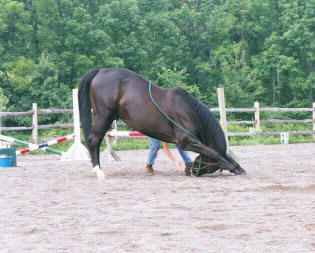
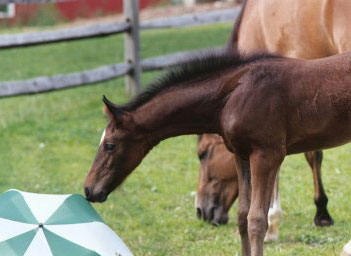
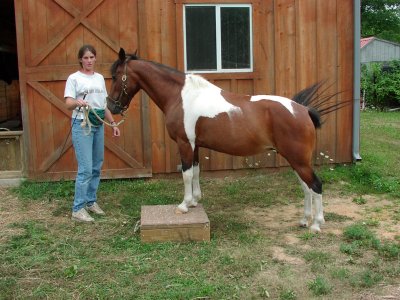
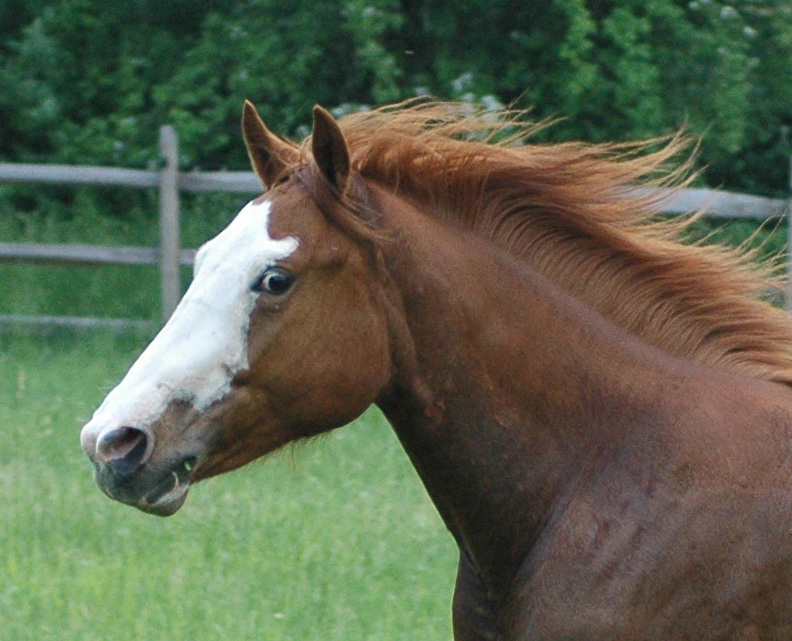
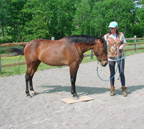
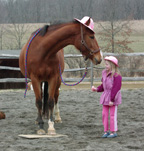
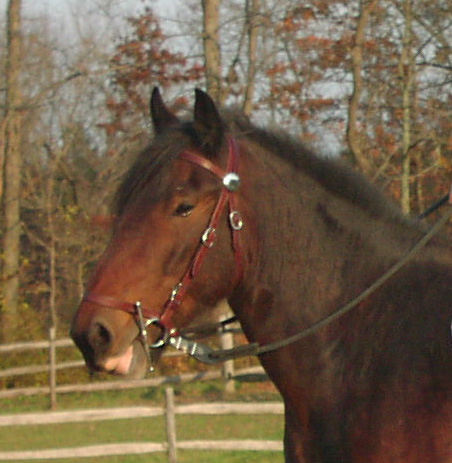
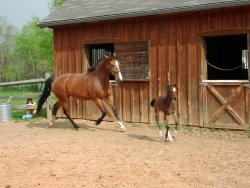 |
|
l
The Nudge
Last night Stella nudged me. I guess that might seem
insignificant and at some point in time, I might not have realized what it
meant. Even when it happened, I took note and thought it was
interesting, but I did not realize I would still be thinking about it today. But
that moment has stayed with me. It was the first moment of clear
communication where I felt that Stella was trying to communicate with me
in a conscious way, instead of just showing standard horse behaviors that convey
frustration or anxiety, which I then had to interpret. I
think the moment has stayed with me because this month I have been thinking about horse
communication. Not just the obvious ways that horses communicate by neighing,
body language and movement. But also some of the more subtle ways that horses
show us how they are feeling and what they do or do not want to do. There have
been some interesting discussions on the internet lists about how hard it is to
interpret a behavior such as licking and chewing or ear pinning
without seeing the behavior as it is occurring and understanding it within the
context of what is going on. One horse's ears may pin in concentration
while another may pin due to anxiety or displeasure. There are lots of
other little clues that help the handler evaluate what the ear pinning means and
sometimes we are not even aware that we are using them, so it is hard to explain
why we feel the ear pinning means what it does. I think nudging falls into the
same category of behaviors that can mean different things depending upon the
situation. One of
the reasons I have been thinking about communication is a book I am reading
(Suzanne Clothier's "If Bones Would Rain From the Sky" - which I highly
recommend). Her focus is on developing the relationship you want with your
dog, a relationship that goes beyond the basics of having a well trained dog,
but expands to include being connected with your dog. It has made me
re-examine my relationships with my horses and make sure that I am listening to
them. My horses are kept at home so I see them all the time and I think I
know them pretty well. This is a good thing, but it also means that slow and
subtle shifts are not always so easy to identify. It is always good to
take a step back every now and then to make sure that I am not missing anything. With
some of the horses, analyzing our relationship and how the horses are feeling seems
quite straight-forward. These are the ones who are pretty easy-going and
if something is really bothering them, they let me know because there will be a
significant change in their behavior. I am sure that because they are
easy-going, there are things that get overlooked because they don't make a big
fuss over them. But it seems to work out. It is the horses that wear
their emotions on their sleeves that I find difficult. It can be hard to
sort out what is a real problem when it is mixed in with daily changes due to
general moodiness, anxiety or bad timing (is it too close to lunchtime?, too
hot? etc..). These are the horses that are giving out so much information
about how they are feeling and what they do or do not want to do, that I end up
having to sift through lots of material just to find a few relevant pieces. So
perhaps because I was thinking about horse communication, that little interaction
seemed particularly important to me and prompted me to write this article. I have
not introduced Stella yet and at some point, I will write up her story and what
I have been doing with her. Stella is a 6 or 7 year old pony mare (Welsh x Holsteiner) who came to me in mid April. She had been at a rescue but they were
unable to place her because of her behavior (rearing, pulling back when tied,
general difficulties with any husbandry work- vet, farrier etc..). I took
her on as a project and have been working on improving her ability to handle
regular aspects of horse care. I
started by teaching her to target and doing some mat work. She is a very nervous
and high strung pony. If I asked for anything that she made her
uncomfortable, she would move her feet. If she could walk away, she would. If
she could not, she would paw. It took a lot of time and persistence to get
her to do mat work without pawing. Any time I taught anything new, she would add
in pawing, so it was difficult to get "clean " behaviors where she was doing the
desired behavior (head down, baby gives, mat work, targeting) without also
clicking for pawing. She did not like to be restricted by her halter or
the lead. She would lead fine as long as there was slack in the line or we were
going where she wanted. But she would pull back if I she got pressured or felt
the lead and did not want to go forward. I have been slowly chipping away at
things, teaching her about following the feel of the lead and helping her to
accept a small amount of pressure. I would say we have made slow but steady
progress. I think
there are some physical issues going on as well. She has odd wear patterns on
her feet and some odd postural things she does, as well as not moving in a
connected and balanced manner. Because she has a history of not handling equine
professionals well, I wanted to give her some time to settle in before I had
anyone evaluate her. I have gotten her comfortable with foot trimming my
doing it myself in very small increments. I spent some time desensitizing her to
shots and was able to get her vaccinated without difficulty. So she
has made a lot of progress but I was not sure how well she really understood
clicker training. It is clear that she knows that if she does things I ask, she
will get a click and a treat. But even after all the mat work I have done, she
does not see the mat and eagerly walk up on to it. I have to ask her and then
wait until she puts both feet on and stays there. She does a lot of "one foot
on, one foot off, and switch..." I had not gotten the feeling that she
really understood about offering behaviors or that she could communicate with me
in a clear and meaningful way. I would say that she communicated with me
by changes in her body language so I was certainly getting information from her
about her state of mind, but these were not behaviors that she was doing
intentionally for the purpose of communicating with me. Last
night I was working with her in the ring. I have five behaviors I am working on
with her. I am trying to improve her mat work with both front feet and with her
hind feet. I am working on baby gives and WWYLM in a very basic form.
And I have done some Stand Quietly While the Grown-ups are Talking.
I divide up my work session and do a little walking between working on different
behaviors. Usually she is pretty clear about what we are working on, but
last night when I finished doing WWYLM and asked her to stand quietly, she was
not sure what I wanted. I was just standing still with my arms folded and she
kept offering lateral work away from me. At some
level, I felt like she was offering to bend and soften and walk around me
because we had just been working on that , but there was still some element of
her need to move her feet when she got anxious. And that is a behavior I do want
on cue, so I just waited her out and clicked her for stopping. After a few
clicks, she stopped moving and then I was clicking for having her head away from
me. She is not very muggy, but she will sort of dive at me with her nose if she
is frustrated. I have seen this mostly when I ask her to pick up her feet and
she is having balance issues or when I was working on baby gives. It is sort of
an anxious, sharp movement. Last night she was not mugging me at all, but she
was turning her head toward me, so I just waited for a moment when it was
straighter. She went
for a moment without a click and then she nudged me. It was a very polite nudge,
not a "give me the food" or "I am upset" nudge. It was more of a "pay attention
to me" nudge. She nudged me and then took her head slightly away. She
probably nudged me three or four times before she moved her head far enough away
that I could get in a click. Then once I clicked her a few times for
having her head away, she was successful at doing that and did not nudge me
again. I did a little more work with her and then put her away, but that
nudge has stayed in my mind. Why? Why
did it seem so significant to me? I have had a lot of horses nudge me and in
general, it does not make an impression. Usually I treat it as a form of mugging
and I would prefer that the horses not do it, although it is preferable to
biting, nibbling, pushing and other related behaviors. But somehow with Stella
it was different. It was the first time she clearly realized that she could
communicate with me and she did it in a very deliberate and thoughtful way.
Instead of walking off or pawing, or pulling back, she just bumped my hand.
This
morning in thinking about it, I realize that I had taught her to target my fist,
so bumping my hand was a behavior that she had practiced and been reinforced
for. I could just say that she was not getting clicked for one thing so
she tried another. It is also possible that she bumped my hand because that is a
horsie thing to do. But it had such a deliberate quality to it and
whichever it was, I don't think that changes anything. She was not getting
clicked and instead of getting upset, she chose another behavior to try and
communicate with me. I think THAT is what I found so fascinating about the whole
interaction. She finally figured out that clicker training did not just allow me
to communicate with her, it meant she could ask me questions too, even if they
were as simple as asking "did you want this instead?" She was finally
thinking for herself instead of being totally dependent upon me to help place
her or set her up to earn her click. I will
be interested to see if this is the start of a breakthrough for her. I think
this is such a significant part of clicker training. I take it for granted with
my other horses because they ask questions and offer things all the time.
I had forgotten how huge it is for a horse to go from reacting to whatever the
handler does to trying to actively figure out what that person might want.
And it all goes back to seeing behaviors not as isolated and easily interpreted
actions, but to understanding the context in which they occur. For Stella, those
nudges were not undesirable and signs that she was stressed. They were a sign
that she was finally starting to think clearly and trusting that she could
communicate with me and I would listen. And for that reason, I welcomed
them, for a while at least...
Home |
Articles |
Clicker Basics |
Community |
FAQ |
Getting Started |
Horse Stories |
Links |
Photos |
Resources
|
||||